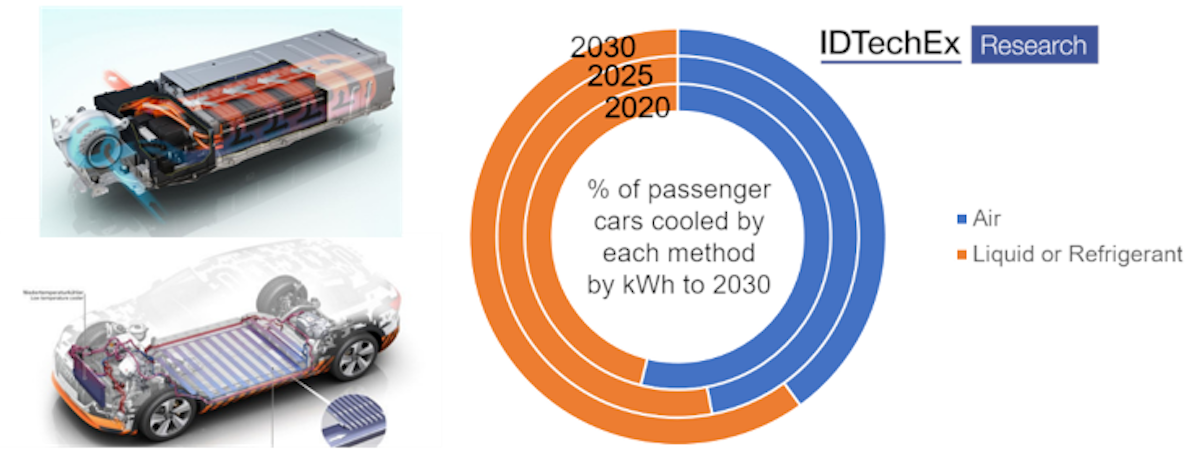There is a strong agreement that the market for electric vehicles is increasing, but there is a significant portion of consumers that are not yet convinced; the main concerns relate to range anxiety, battery longevity and safety. As this market increases, and for it to reach its full potential, there is further need to address these issues and thermal management is a large factor in doing so. Effectively managing heat across an electric vehicle can provide improved performance, range, charging, longevity and safety.
This report from IDTechEx on Thermal Management for Electric Vehicles covers the batteries, power electronics and motors, considering the material and engineering solutions used throughout each component. Extensive primary information is gathered to give a technically detailed overview of the field. The technologies currently in use across the manufacturers are described, analysed and forecast. Additionally, emerging technologies are addressed and discussed for their suitability in future applications. The breakdown of active and passive methods of cooling for Li-ion batteries in electric vehicles is considered and forecast for the next 10 years utilising total and average kWh numbers for the electric vehicle market in this time. The mass of thermal interface materials used in gap filler and conductive adhesive applications is forecast through to 2030. In addition to this, the report provides the market for thermal interface materials, considering the breakdown between battery and hybrid cars, trucks, vans and buses. The technologies that are currently used for the thermal management of various vehicles power electronics and motors are analysed along with predictions for the prevailing trends and methodologies.

IDTechEx forecast for percentage of vehicles that will be cooled by air, liquid or refrigerant through 2020-2030, showing a trend towards liquid cooling
Operating or charging a battery in cold conditions results in reduced capacity, accelerated cell degradation and reduced efficiency, whilst increased temperatures also result in reduced capacity. It also has serious implications for safety, with thermal runaway being a major concern. If a cell becomes too hot a thermal runaway may be triggered whereby after the initial event, neighbouring cells are also ignited resulting in chain reaction which can lead to fire and potentially an explosion. There have been several high-profile incidents of this from South Korean energy storage fires to the fires from notable OEMs such as Hyundai and Tesla. Whilst these incidents are generally quite rare, when an electric vehicle goes into thermal runaway the heat output increases exponentially with time, making extinguishing a vehicle fire much harder as time goes on, therefore early management and detection of such events without false positives is crucial.
Whilst thermal management is a key consideration for any electric vehicle, there is no consensus on the best design. This stems from the fact there is also no consensus on the best way to construct an electric vehicle, from the battery cell, module and pack construction to the type of electric motor used. Companies like Tesla use many cylindrical cells in their packs with an interweaved water-glycol coolant circuit, BMW use prismatic cells with a large refrigerant cooled plate beneath and players like Nissan and Toyota are dedicated to the continued use of air cooling. Whilst the array of designs can be somewhat overwhelming, it provides a plethora of opportunities for manufacturers to create thermal management solutions for electric vehicles. This is especially relevant in the near future as regulations relating to electric vehicles and thermal runaway will be enforced, depending on the regulations implemented several manufacturers are going to need to rethink their designs, or at least implement much more thorough thermal management technologies.
Like the batteries of electric vehicles, there are several designs used for cooling of the motors, primarily these are air, oil and water-glycol but once again there is no consensus and the choice is often determined by considerations relating to the whole vehicle thermal management. There are also several emerging technologies in this field in addition to some advancements in motor design to prioritise thermal efficiency.
In addition to the other sectors mentioned, the power electronics are a key component for any electric vehicle and their suitable thermal management is equally important. There are trends towards higher power density and operating temperatures, approaches and techniques to sustain this trend are covered regarding wire bonds, solder and advanced substrates. The incorporation or removal of thermal interface materials for the power electronics varies between OEMs and several electric vehicle use cases are covered.
Key topics:
- Li-ion Battery Cooling - Air, Liquid, Refrigerant and Immersion
- Thermal Interface Materials
- Heat Spreaders and Cooling Plates
- Thermal Runaway Importance, Detection and Prevention
- Battery Enclosures
- Traction Motor Cooling Mechanisms
- Power Electronics Cooling




